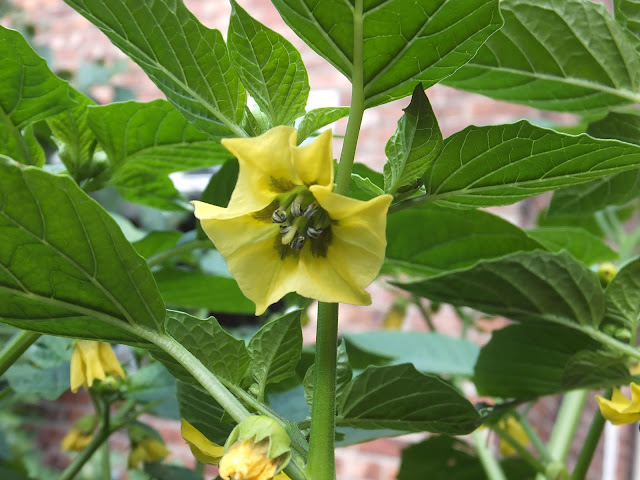I grew two plants of a green Tomatillo this year. There was no name for the variety on the Suttons website.
More after the break
The plant is now known as Physalis philadelphica and was first described by European botanists in 1786. Many gardeners (and Suttons Seeds) still know it as Physalis ixocarpa. Physalis ixocarpa was decided to be the same plant as Physalis philadelphica in 1967. The centre of variety for the tomatillo plant is in Mexico. The Aztecs used this fruit in many dishes. It is an essential component of the modern Mexican salsa verde.
The sweet, bright orange fruit available as Physalis in the exotic fruit sections of many supermarkets is Physalis peruviana, usually imported from Colombia. Both of these plants grow easily here in the UK and produce abundant fruit. You also occasionally see Physalis pruinosa from France in organic veg shops, with paler yellow fruit that are sweeter and less sharp but taste distinctly of pineapple with a hint of apricot.
The bees love the abundant flowers. The red-rumped variety of bumblebee were the most common visitors. They always had full pollen baskets. Unfortunately they were also far too quick for me to get good photos.
The plants were rather small, lanky and pale when they arrived, perhaps affected by the heatwave. I should have grown them from seed but thought I was too late to sow when I ordered the plants in mid-April. The plants did not arrive until mid-May. I would have grown the more spectacular purple variety if I had grown them from seed. They not only taste better but have lots of purple anthocyanin pigments as recommended by the Government to be included in a healthy diet for its beloved citizens.
I was afraid the slugs would get them as I messed up ordering the slug-killing nematodes. The nematodes arrived during a hot, dry spell so they were not as happy as they usually are in Manchester in Spring. The copper tape around the plant pots seems to have deterred the slugs and snails long enough to allow the tomatillos to get big and tough enough to look after themselves.
There have been nibbles taken out of some leaves but nothing drastic and no visible pest infestations. I saw a couple of whiteflies but they don't seem to have established a colony. A few bits got damaged in the high winds but proper support would probably have prevented that. If you want the plants to grow up you probably need to provide some substantial support, the branches get very thick and heavy even before they are loaded with fruit.
This plant is a lot easier to grow than a tomato.
 |
| If the abundant flowers produced from July to September all pointed upwards like this odd one then tomatillo would be one of the favourite ornamental plants of our gardens. |
 |
| The husk/cod/bladder/paper lantern inflates first then the fruit inside grows to fill it. You can see the shadow of the small fruit at the top of the lantern. |
 | |
|
 |
| About 860g of ripe green tomatillos. |
I have just removed the husk and stem, washed with water, chopped them into quarters and added them to stews and pilaf. They do contain a lot of tiny, hard seeds so I might make a puree in the liquidiser and sieve it to get the seeds out, next time. The fruit are often compared to a sharp tomato, like a cross between a lime and a beef tomato seems a common reference. Once cooked they develop a lovely and rather unique flavour, not much like tomatoes.
I have tried them on their own but they are not as nice to eat raw as the purple variety I once grew. Perhaps next year, if I am organised enough at the end of March.





